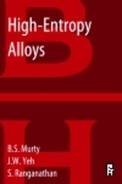Foreword
Vice Chancellor, The University of Bradford, UK
In the 1970s, I became excited about the idea of multicomponent alloys. I realized that the materials we use are almost all based on a single component with a primary property and an admixture of small amounts of other components to provide secondary properties. Effectively, all our known materials are at the corners and edges of a multicomponent phase diagram consisting of all possible components. This means that there is a vast number of possible materials in the middle of this phase diagram which have never been investigated. It turns out that this unknown field of materials is truly enormous, and the number of unexplored materials is many times greater than the number of atoms in the universe.
This explains why we keep discovering exciting new materials: high-temperature superconductors, glassy alloys, quasicrystals, compound semi-conductors, and so on. And we will keep finding exciting new materials as long as we have the courage as experimenters to try innovative, new mixtures of constituents. I now tell every PhD student in materials science to be aggressive and ambitious in exploring this amazing array of potential new materials.
In the 1970s, I found it hard to persuade other people to be similarly enthused by my ideas on the topic of multicomponent alloys. I could not get funding, and I could not get research colleagues to undertake preliminary experiments. Everyone wanted to work in much better known fields. Everyone was very conservative. Finally, I persuaded a young undergraduate student, Alan Vincent, to do preliminary work. He immediately found exciting results including the first high-entropy alloys. Nearly 20 years later, I persuaded another young undergraduate student, Peter Knight, to repeat the work. And finally, a couple of years later, my long-standing research colleague, Isaac Chang, repeated the experiments for a third time, but more carefully and with more time to document the results fully and in a publishable way. We presented the results, first found by Alan Vincent in 1979, at a conference in 2002 which was published in 2004, more than 25 years since my first idea. In parallel, Professor S. Ranganathan (my old friend, Rangu) and Professor J.W. Yeh (my new friend, Jien-Wei) published independently papers on, respectively, material cocktails and high-entropy alloys, closely related and essentially similar concepts to my idea of multicomponent alloys.
In the last few years, as a consequence of the outstanding continuing work by Jien-Wei, the field of multicomponent and high-entropy alloys has taken off, with literally hundreds of publications each year. Most notably, Vincent, Knight, Chang, and I discovered in the late 1970s a single FCC solid solution consisting of five components in equal proportions, namely, FeCrMnNiCo. This alloy has been shown to have outstanding mechanical properties, with high strength and high ductility. I realized in the late 1970s that the mechanical behavior of this material would be very unusual. Metal and alloy mechanical properties depend primarily on the behavior of dislocations and how they move in response to stress, but the concept of a dislocation as a line defect with a consistent core structure becomes complex when there are many different components distributed on a single lattice.
Professors Murty, Yeh, and Ranganathan have now written a book on this new group of materials. The book covers the structure, processing, and properties of the materials, insofar as we have been able to explore them. Some multicomponent alloys are solid solutions with high entropy. Some are not. In either case, there are wonderfully exciting new structures and properties to be found. This book is the first about this field. It contains many valuable and interesting insights. But ultimately it can only hint at the full range of new materials which remain to be discovered. The authors should be congratulated on doing an important job which will help us on our exciting, exploratory journey into the materials of the future.
